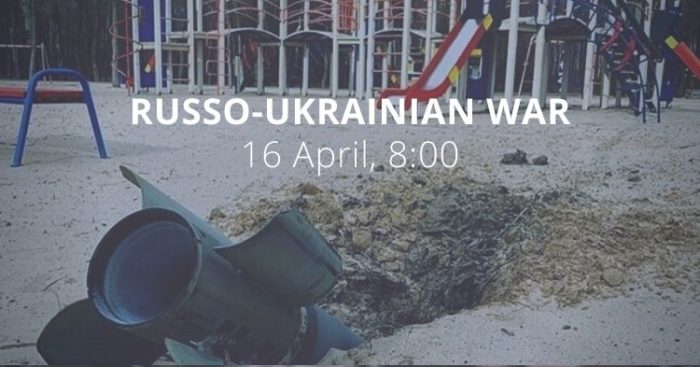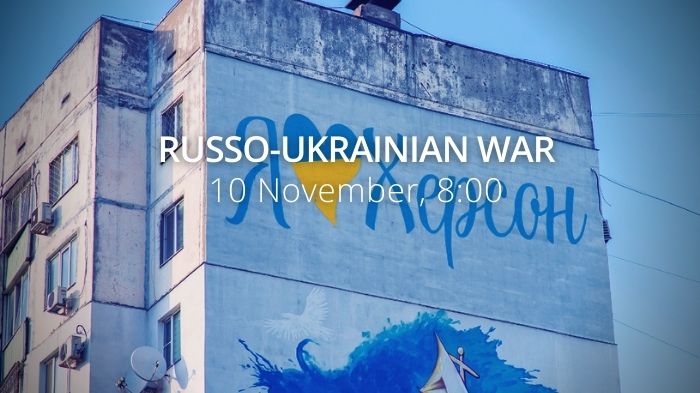The report is based on media reports, expert analyses and official information posted online.
Situation
According to information from the General Staff as of 06.00 24.03.2022, supplemented by its [midnight assessment]:
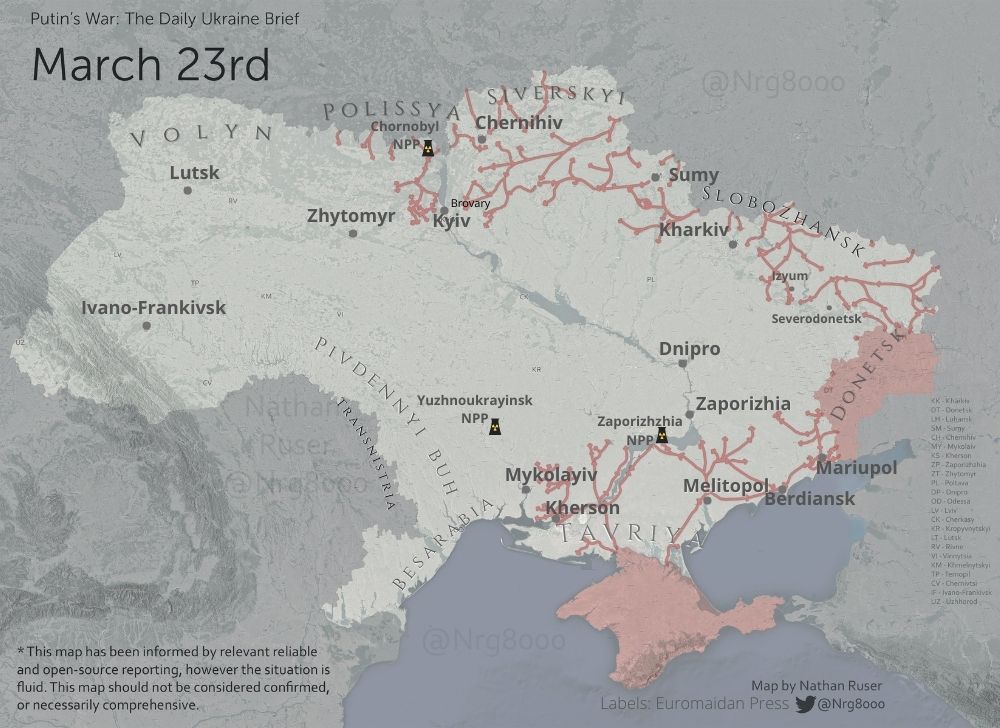
“The Defence Forces continues to conduct a defence operation in the Eastern, South-eastern and North-eastern directions. The enemy did not succeed in any of them. Groups of troops deter the enemy in these areas, conduct a stabilization operation and perform territorial defence tasks.
[The enemy has not fulfilled the task of reaching the administrative borders of the Donetsk and Luhansk regions, encircling the city of Kyiv or gaining control of the left bank of Ukraine.]
[They are not abandoning their attempts of resuming offensive operations to capture Kyiv, Chernihiv, Sumy, Kharkiv, and Mariupol.]
[No offensive operations were conducted by the enemy in the Volyn direction. There remains the possibility of the involvement of certain units of the armed forces of the Republic of Belarus in the Russian aggression against Ukraine. According to the available data, there are up to 4 Battalion Tactical Groups from the armed forces of Belarus located near the Ukrainian-Belarussian border.]
[In the Polissya direction the enemy has intensified air reconnaissance in the settlements of Glibivka, Lutizh, Lebedivka. Along the line of contact, the enemy continues to supply the engineering of positions and installation of minefields. [During Wednesday] the enemy carried out artillery shelling in the areas of Kalynivka, Horinka, Pushcha-Vodytsia, Novi Petrivtsi, Pomannivka and the northeastern outskirts of Kyiv.]
[In the northern direction the enemy, with the help of separate units of the Central Military District, continues to concentrate its efforts and means to attempt to resume offensive operations.]
[In the Cheriniv directions the enemy is attempting to blockade and occupy the city of Chernihiv, has conducted air reconnaissance of the city’s areas, likely with the aim of estimating the result of airstrikes and identifying the positions of the Ukrainian Armed Forces units.]
[In the Brovary direction the enemy has been stopped. They attempted to break through the defensive positions of our armed forces’ troops to reach the north-western outskirts of Kyiv, and had no success.]
[In the Slabozhansk direction the enemy carried out artillery strikes on the city of Kharkiv, but the occupying forces failed to carry out active offensive operations.]
[In the direction of Sumy, units of the 1st Guards Tank Army did not conduct any active offensive operations. The main efforts were focused on blocking the city, and carrying out artillery and airstrikes on civilian infrastructure objects.]
[In the direction of Izum the occupants attempted to break through the defence of our troops in the regions of Donetske, Topollske, Kam’yanka, and the fighting continues.]
[In the Donetsk direction the enemy is shelling the units of the Armed Forces of Ukraine in the vast majority of directions. The main efforts are being concentrated on seizing the settlements of Rubizhne, Sievierodonetsk, Popasna, Verkhnyoteretske, Mar’yinka, and Mariupol. Re-grouping and building groups are taking place to resume offensive operations. They are actively carrying out reconnaissance and attempting to move forward, bypassing the positions of our troops and places of resistance without engaging in battle.]
[In the region of Popasna, with the help of artillery, the enemy continued attempts to move further into the city and secure their previously captured positions, but had no success and suffered losses.]
[They continue to carry out air and artillery strikes on objects of the civilian infrastructure of Mariupol, and have had no success.]
[In the Tavriya direction there have been no changes in the composition or position of the enemy.]
[In the Pivdennyi Buh directions the enemy continues to supply the engineering of positions. Measures are being taken to restore combat capabilities, replenish ammunition, and fuel and lubricants with the aim of preparation to renew offensive operations.]
Enemy aircraft continue to be active, striking from the air, and more than 250 aircraft flights have been recorded in the last 24 hours (60 more than on March 22). The enemy’s main targets remain military and civilian infrastructure in Kyiv, Chernihiv and Kharkiv oblasts.
The Air Force of the Armed Forces of Ukraine repulses concentrated missile and airstrikes and air attacks of the enemy, air cover of important objects of Ukraine and groups of troops. For the previous day, 11 enemy air targets were hit (7 planes, 1 UAV, 1 helicopter and 2 cruise missiles.) Information about their final downing is being clarified.
In the temporarily occupied territories of Kherson oblast, in connection with peaceful protests against the occupation, the enemy resorted to terror of the local population, actively using the Russian National Guard units to prevent these actions of civil disobedience to the occupation authorities.
[Due to suffering numerous losses of the command of the occupational forces, to improve their situation on the front, they continue to form and move additional units of armed forces of the Russian Federation to the Ukrainian borders. According to the available information, to recover from the losses of the 144th motorized rifle division of the 20th field army of the Western Military District, contracting measures have been intensified in the military commissariats of the Smolensk region. In order to replenish the occupational forces, soldiers returning from business trips in Syria are also being recruited.]
[Remains of units of the Eastern Military District and airborne forces are arriving from Russia at the border with Ukraine at the Gomel region in the Republic of Belarus.]
The enemy continues to lose manpower and equipment in all directions. The total resistance of the Ukrainian people continues.”
The large landing ship Orsk of the Black Sea Fleet of the Russian occupiers was damaged in the Russian-occupied port of Berdiansk, the General Staff of Ukraine claim.
The New York Times has analysed dozens of battlefield radio transmissions between Russian forces in Ukraine during the initial invasion of Makariv, a town outside Kyiv. They reveal an army struggling with logistical problems and communication failures. The Russian forces were communicating on an open frequency. “In this series of exchanges, we hear how comms failures delay urgent requests for Russian air support amid mounting casualties. Thirty minutes after the unit requested help: “You forgot about air support, [expletive] air support! You forgot!” The radio chatter is full of Russian troops who lack critical supplies, too. Two examples: “I urgently need refuelling, water, and food.” “Vehicles stalling in the road. Urgently need fuel.” This happened on 27 February, 3 days into the invasion.
To date, the Syrian government’s previous promises of a systematic supply of mercenaries to the Russian army have not been fulfilled, the Defence Intelligence of Ukraine reports. The promised “easy walk” was replaced by reports of fierce fighting and heavy losses of the Russians. Most of the Syrian military is not willing to risk their lives for illusory financial means.
According to British Defence Intelligence, (last 24 hours):
- Russian forces have almost certainly suffered thousands of casualties during their invasion of Ukraine.
- Russia is likely now looking to mobilise its reservist and conscript manpower, as well as private military companies and foreign mercenaries, to replace these considerable losses.
- It is unclear how these groups will integrate into the Russian ground forces in Ukraine and the impact this will have on combat effectiveness.
- Ukraine is increasing pressure on Russian forces north-east of Kyiv. Russian forces along this axis are already facing considerable supply and morale issues.
- Ukrainian forces are carrying out successful counter-attacks against Russian positions in towns on the outskirts of the capital and have probably retaken Makariv and Moschun. There is a realistic possibility that Ukrainian forces are now able to encircle Russian units in Bucha and Irpin.
- It is likely that successful counterattacks by Ukraine will disrupt the ability of Russian forces to reorganise and resume their own offensive towards Kyiv.
As of Thursday 24.03.2022, the approximate losses of weapons and military equipment of the Russian Armed Forces from the beginning of the war to the present day:
- personnel – more than 15,800 people (+200),
- tanks – 530 units (+13),
- armoured combat vehicles – 1597 units (+19),
- artillery systems – 280 (+13),
- multiple rocket launchers – 82 (+2),
- air defence means – 47 (no change),
- aircraft – 108 (+7),
- helicopters – 124 (no change),
- automotive technology – 1033 (+25),
- light speedboats – 4 units (no change),
- fuel and lubricant tanks – 72 (+2),
- UAV operational and tactical level – 50 (+8)
- Special equipment – 16 (+1)
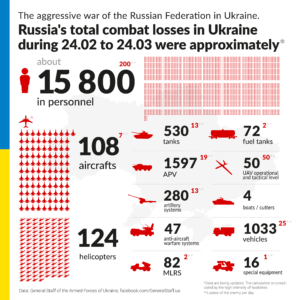
Humanitarian
The Office of the United Nations High Commissioner for Human Rights (OHCHR) reports 2,571 civilian casualties, including 977 killed as of 22 March, figures that are likely much higher and will continue to rise.
More than 650 residential buildings have been destroyed across Ukraine, while around 3,780 have suffered varying degrees of damages between 24 February and 22 March, according to the State Emergency Service of Ukraine (SESU). Ongoing fighting prevents a full assessment of damages caused by Russia.
The World Health Organization (WHO) verified 64 attacks on health care in Ukraine, leading to 15 deaths and 37 injuries. In addition, according to the Ministry of Education and Science, 548 educational facilities have been damaged amid ongoing hostilities, 72 of which have been destroyed as of 23 March.
According to UNHCR 3,626,546 refugees has been registered as of 22 March. The UN says that so far Poland has taken in 2,144,244 refugees, Romania 555,021, Moldova 371,104, Hungary 324,397, Russia 271,254, Slovakia 256,838 and Belarus 4,938.
Almost half of Ukrainians separated from their families because of the war, according to a poll conducted by the sociological group “Rating” on March 19, 2022, Life Pravda reports. About 44% of Ukrainians were forced to separate from their families because of the war. “Separation from the family against one’s will is a psychologically difficult ordeal, especially during a war that creates uncertainty about future family reunification,” say sociologists. In addition to separation, 19% of Ukrainians were forced to leave their place of residence. Most of these are residents of eastern Ukraine. At the same time, 93% of them plan to return home by the end of the war.
Environmental
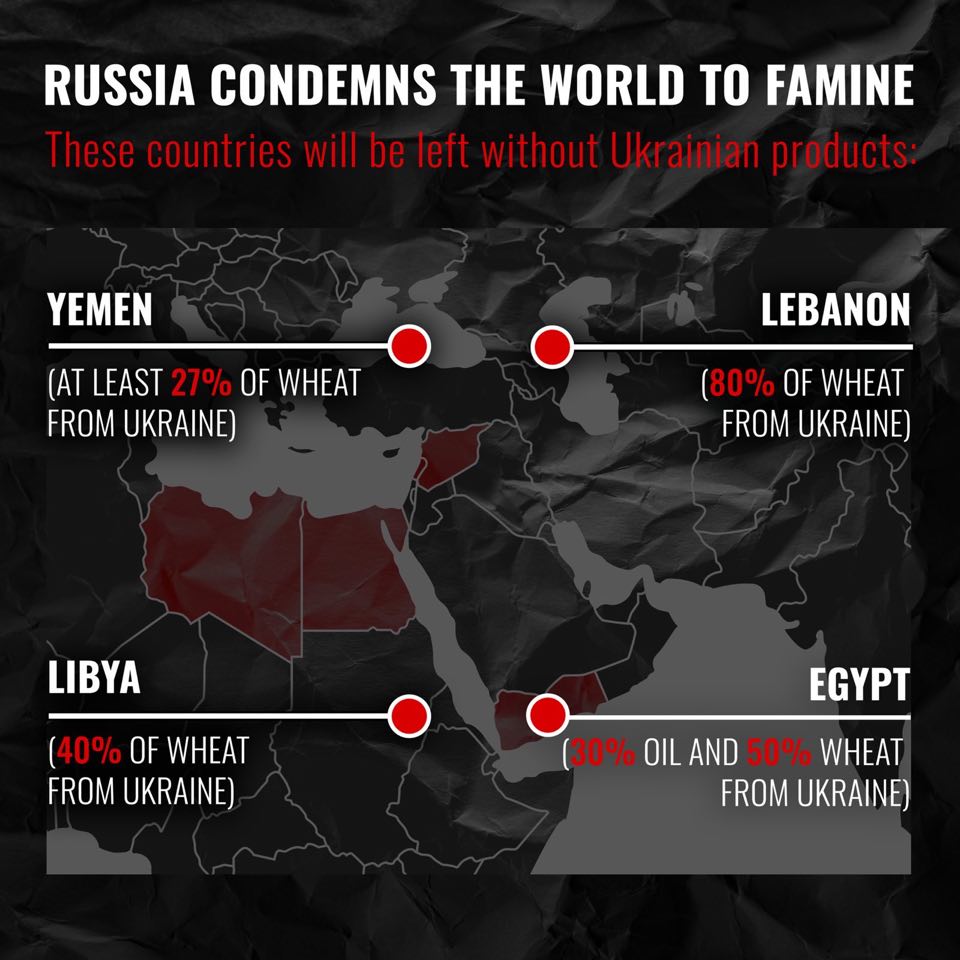 Russia’s invasion intensifies famine in the Middle East and North Africa, the Centre for Strategic Communications and Information Security under the Ministry of Culture and Information Policy of Ukraine reports. Because of the war, Ukraine has had to suspend grain and food exports. The fighting could seriously disrupt the upcoming harvest, especially if the war continues until the planting season begins in April. Lebanon, Egypt, Libya, and Yemen may be left without Ukrainian wheat, oil, and flour. As well as the region of north-western Syria, which receives wheat and flour from Türkiye, which in turn imports 90% of its flour from Ukraine
Russia’s invasion intensifies famine in the Middle East and North Africa, the Centre for Strategic Communications and Information Security under the Ministry of Culture and Information Policy of Ukraine reports. Because of the war, Ukraine has had to suspend grain and food exports. The fighting could seriously disrupt the upcoming harvest, especially if the war continues until the planting season begins in April. Lebanon, Egypt, Libya, and Yemen may be left without Ukrainian wheat, oil, and flour. As well as the region of north-western Syria, which receives wheat and flour from Türkiye, which in turn imports 90% of its flour from Ukraine
Legal
Posting POW footage on social media may constitute human rights violations, the Military Times reports.
“Showing videos of POWs, regardless of the content or under what conditions it is obtained, is a violation of international law, experts say. Articles 13 and 14 of the third Geneva Convention protect POWs from insult and from becoming the object of public curiosity, Leila Sadat, special adviser on crimes against humanity to the International Criminal Court, told Military Times.”
Support
Sweden to supply additionally 5000 anti-tank weapons to Ukraine, Interfax reports. Swedish Defense Minister Peter Hultqvist also said the country would supply mine clearance equipment to Ukraine.
Lithuania will provide 10 million euros in military aid to Ukraine, Lithuanian President Gitanas Nausėda said on Wednesday, LRT reports. “Our concrete assistance depends more on the production capacity and the ability to deliver that equipment in the shortest time possible, rather than on how much money we are ready to allocate,” he added.
The British Prime Minister will announce a major new package of support for Ukraine today at the NATO and G7 leaders’ meetings, as he calls on the international community to stay the course on Ukraine and stand against tyranny. “The measures announced today include 6,000 missiles, consisting of anti-tank and high explosive weapons, and £25 million in financial backing for the Ukrainian military. The £25 million in new non-ODA funding from the Conflict, Stability and Security Fund will help to pay the salaries of Ukrainian soldiers, pilots and police and ensure the armed forces are well equipped with high-quality equipment.”
President Biden will announce sanctions this week on hundreds of members of Russia’s lower house of Parliament, as the United States and its allies reach for even stronger measures to punish President Vladimir V. Putin for his monthlong invasion of Ukraine, The New York Times reports.
“The announcement is scheduled to be made during a series of global summits in Europe on Thursday when Mr Biden will press Western leaders for even more aggressive economic actions against Russia as its forces continue to rain destruction on cities in Ukraine.”
Ukraine calls on Germany and France for help amid fears it is running out of the weapons needed to fight off the Russian invasion, the Daily Mail reports. “Ukraine is said to be quickly running out of the weapons it needs to hold off Russian forces – and has called on France and Germany to send more arms.” Ukraine has said it is fast running out of the weapons it needs to destroy Russian aircraft and tanks and urged Germany and France to honour their pledges and send more arms, The Times reports.
NATO to help Ukraine deal with chemical threats from Russia, Bloomberg reports. NATO Secretary General, Jens Stoltenberg, told reporters that he expects leaders meeting in Brussels Thursday “will agree to provide additional support including cybersecurity assistance, as well as equipment to help Ukraine protect against chemical, biological, and radiological and nuclear threats. Any use of chemical weapons would totally change the nature of the conflict and it would be a blatant violation of international law and have far-reaching consequences,” Stoltenberg said, adding contamination could spread to NATO countries.”
Support for war against Ukraine has increased further in Russia, Ukrainska Pravda reports. Support for Russia’s war against Ukraine continues to grow among Russians, while protest potential is declining, according to All-Russian Public Opinion Research Centre (VTsIOM) as of 17 March. “The decision to conduct a “special military operation” by Russia in Ukraine is most likely supported by 74% of Russian citizens. The share of supporters has increased by 9 percentage points compared to 25 February.”
New developments
- Sending peacekeepers to Ukraine would be a direct confrontation between Russia and NATO, Ukrainska Pravda reports. “Russian Foreign Minister Sergei Lavrov said on Wednesday that sending peacekeepers to Ukraine could lead to a direct confrontation between Russia and NATO.”
- Russia claims a shell was fired into the Russian Federation from a part of Ukraine where Russian occupiers are present, Ukrainska Pravda reports Wednesday.
- The UN Security Council rejects a Russian resolution on Ukraine’s suffering that did not mention the invasion, The New York Times reports. Thirteen of the 15 members of the council voted against the resolution. China was the only country on the council to support it. “It really is unconscionable that Russia would have the audacity to put forward a resolution asking the international community to solve a humanitarian crisis that Russia alone created,” said Linda Thomas-Greenfield, the US ambassador to the UN
- The US makes contingency plans in case Russia were to use its most powerful weapons, The New York Times reports. A team of national security officials to sketch out scenarios of how the USA and its allies should respond if President Putin unleashes his stockpiles of chemical, biological or nuclear weapons. They are also examining responses if Russia reaches into NATO territory to attack convoys bringing weapons and aid to Ukraine, or seeks to extend the war to neighbouring nations, including Moldova and Georgia, and how to prepare European countries for the refugees flowing in on a scale not seen in decades. Those contingencies are expected to be central to an extraordinary session here in Brussels on March 24, when President Biden meets leaders of the 29 other NATO nations
Assessment
The Institute for the Study of War has made the following assessment as of Wednesday 23 March:
(quote) “Russian forces continued to settle in for a protracted and stalemated conflict over the last 24 hours, with more reports emerging of Russian troops digging in and laying mines—indications that they have gone over to the defensive. Ukrainian forces continued to conduct limited and effective counterattacks to relieve pressure on Kyiv, although the extent of those counterattacks is likely less than what some Ukrainian officials are claiming. Russian efforts to mobilize additional forces to keep their offensive moving continue to be halting and limited. Russian progress in taking Mariupol city remains slow and grinding. Increasing Russian emphasis on using air, artillery, and rocket/missile bombardments of Ukrainian cities to offset forward offensive momentum raises the urgency of providing Ukraine with systems to defend against these attacks.
Russian mobilization efforts are likely becoming urgent given Russian losses in the war. The Wall Street Journal cites an unnamed NATO official claiming that Russia has lost as many as 40,000 troops killed, wounded, or missing of the roughly 190,000 deployed to invade Ukraine. That assessment, which is plausible given previous estimates of Russian combat deaths, must be considered in the context of the assessment offered by an unnamed Department of Defense official on March 21 that Russia had committed a high proportion of its available battalion tactical groups to the war already. The protracting pause of Russian offensive operations in Ukraine and increasing anecdotal reporting of breakdowns in the morale and capability of Russian combat units all accord with these assessments. These reports and assessments collectively suggest that Russia may not be able to find new combat power with which to regain offensive momentum for weeks or even months.
Russian forces are increasingly preparing for protracted defensive operations in various parts of the theater. Numerous reports and satellite images of Russian troops digging defensive positions and laying mines suggest that they have gone over to the defensive and do not anticipate conducting renewed large-scale offensive operations in the near future in a number of locations across Ukraine.
Key Takeaways
- Russian forces continue to go over to the defensive, conducting restricted and localized ground attacks that make little progress.
- Ukrainian forces are conducting limited and successful counterattacks around Kyiv to disrupt Russian operations to encircle the city (which has now become extremely unlikely) and relieve the pressure on the capital.
- The Battle of Mariupol continues as a block-by-block struggle with fierce Ukrainian resistance and limited Russian gains.
- Russia is likely struggling to obtain fresh combat power from Syria and elsewhere rapidly.” (unquote)
An analysis “When will the war end and how to bring our victory closer” (in Ukrainian) by the Centre for Defence Strategies, make the following assessments (extracts only):
Despite the great difference in military potential, Russia’s relative success in this war is only in one plane – the navy. Russia practically occupies the Black and Azov Seas. At the same time, due to the Ukrainian coastal defence, the Russian Federation is not able to come close and successfully carry out amphibious operations.
Russia announced the successful suppression of Ukraine’s air defence in the first hours of the war. But this turned out to be an unfulfilled wish. Three weeks after the war, Russia lost dozens of planes and helicopters, and Ukrainian combat aircraft and air defence still operate and continue to hit a large number of targets every day. [It has failed to gain control of the Ukrainian air space and has consequently lost 232 aircraft and helicopters.]
Its ground assault has failed to reach its initial objectives as well. We remember that more than 15 thousand killed invaders mean three times more wounded according to the adopted methodology. Overcrowded hospitals in Mozyr, Belgorod, Berdiansk and occupied Sevastopol testify to the realism of these estimates. Adding a thousand more prisoners, we concluded that our army has neutralized about half of the original ground group. [A senior NATO military officer says the alliance estimates that Russia has suffered between 30,000 and 40,000 battlefield casualties in Ukraine through the first month of the war, including between 7,000 and 15,000 killed.]
In cyberspace, Russia has failed to cause irreparable damage to Ukraine’s critical infrastructure. The Ukrainian systems are functioning smoothly – banking and financial systems are working, electricity production, gas supply, internet, and mobile communications are still working. Government agencies and news sites are the targets of enemy cyber-attacks daily, but their overall success is low.
In the information field, Russia completely loses both in Ukraine and abroad. Ukrainians demonstrate unprecedented unity and support for the government and the president. Russia’s intention to split society through information attacks and provocations has failed. The Ukrainian people are united, united and powerful. Hatred of the aggressor is nationwide, and any pro-Russian elements are completely rejected by society.
Abroad, especially in democratic countries, Ukraine’s unprecedented support remains. Despite the constant repetition of Russian narratives, the world community does no longer believe Russia.
Ukraine’s ability to withstand total terror against the civilian population and the use of all available forces and means against the Armed Forces and the Troops depends on the continued diplomatic support, assistance with weapons and money from the United States and other countries.
At this stage, the constant is the determination of the political and military leadership, readiness for such a scenario of the defence forces. Therefore, the development of the success of a strategic defence operation is critical.
Does Russia have reserves at home? Yes, there are, but limited. First, the total number of combat-ready ground forces of the Russian Federation is close to 300 thousand, ie almost half of all available capabilities were sent to Ukraine.
But their combat effectiveness, as we see, is quite conditional and heterogeneous. There is still a big question about the other half, it is likely that it is understaffed and will not create an effective combat-ready reserve that can be delivered to Ukraine. If Putin sends all available forces to us and loses most of them, it will lead to the loss of the army altogether. And this is a catastrophe for the Russian Federation.
The myth of the invincible and terrible Russian army has been shattered in the world information space. It will not be restored, even if some operational goals are met in the future.
Low training of soldiers, low level of equipment and technical level of armament, low coherence of their units, critical errors in the command system, lack of clear goals and objectives and terrible morale, multiplied by the inability to organize logistics, led to a stalemate. Their only advantage is quantity.
Therefore, the Russian leadership is replacing its defeats with constant missile strikes, including on civilian targets. Russia is also sending many soldiers to Ukraine, not counting the losses, sending hundreds of pieces of equipment. […]
Given the failure of the maximum escalation by all available means, Moscow will try to compensate for the lack of success by proxy-diplomatic means, similar to the Minsk process tested in eight years. […] This move will give room for attempts to split the unity of our Western partners, who will suffer from political instability caused by slowing economic growth, food security problems, the factor of Ukrainian refugees and others. […]
It is equally important to provide external support and to put the Ukrainian economy in a military position. Given the competent actions of the military leadership and the constant high motivation of society, the latter will be a decisive factor.
The question that worries everyone is: can Putin try to solve the war with chemical weapons or even a nuclear strike? Russia has a long list of prohibited weapons and war crimes and crimes against humanity. […] Provocations with chemical and other weapons with accusations of Ukraine are quite possible The Syrian experience of capturing cities with chemical weapons, ironically and with the involvement of Syrian mercenaries, may become a reality.
The warnings of the Ukrainian military intelligence about the possible involvement of the Chernobyl scenario, in particular, the use of contaminated soil or spent nuclear waste, are not unfounded. […] At the same time, the use of tactical nuclear weapons against Ukraine seems unlikely given the impossibility of achieving certain political goals and the extremely negative consequences for both Russia and the ruling regime there. At present, nuclear deterrence is working as desired by the Kremlin, as evidenced by the refusal to implement a no-fly zone.
But the risk of turning the war into a long-term positional war is certainly there. […] We believe that a peace agreement scenario is very likely. Russia will try to squeeze some conditions, present them at home as a “victory” and reach an agreement before their failure becomes apparent.
Such an agreement will allow Russia to rest and recover, and on occasion – to enter into endless disputes over the state of implementation of agreements such as the Minsk process.
Therefore, any terms of such an agreement should very clearly anticipate the risk that the Russian Federation, in its standard style, will try to violate them immediately after signing […]. In any case, Putin is unlikely to get rid of the obsession with conquering all of Ukraine. He will be stopped only by economic losses, his recognition as a war criminal and the maximum disclosure of losses and mistakes of the command in this war. […]
The Kremlin’s current maximalist demands are incompatible with Ukrainian statehood, so Ukraine must formulate its own. […] Russia’s readiness for real negotiations and withdrawal from the war will also depend on several external factors. Their onset is still in progress, which is why it is impossible to accurately predict the end of the war. There are two main external factors.
The first is the real readiness of the United States and its closest allies to support Ukraine with weapons until victory. The main thing is that it comes in the specification that we need, in the amount that we need, and at the time when we need it. The prospects for this are quite high. But this is a big and hard job.
Secondly: another level of sanctions pressure. Shocked and outraged by the brutal and fascist tactics of war, the liberal-democratic societies of Western countries must translate this outrage into sanctions of a completely different order. Their current soft position in some continental European countries must become unacceptable. Any cooperation of Western business with Russia should be as toxic for this business as cooperation with the regimes of Syria or North Korea.
The world is afraid of this, given Russia’s high integration into the world economy. But this is what will accelerate the suffocation of the economy, Russia’s monetary power, help stop the war and restore world order.
All this time we need to support the resistance of the people, our Armed Forces, develop the economy and work on the implementation of the above tasks.
ME: The Institute for War Studies and the Centre for Defence Strategies represents only two out of many expert communities and individual experts that are calling on NATO to act and/or increase its support to Ukraine. I am one of them.
As NATO ponder its future actions, it’s important to ensure they make decisions based on facts and not claims. The Russian War in Ukraine is a fact. Its violation of international law is a fact. The Ukrainian suffering is a fact. The humanitarian catastrophe is a fact. The Russian threat to European security is a fact. The European dependence on Russian oil and gas is also a fact. The claim that the direct involvement of NATO in the war would lead to a full-fledged war in Europe is just that: A not substantiated claim. If it was a fact, NATO deterrence has already failed.
I am, therefore, tempted to make a slightly ironic analogy: If NATO was a car, it would probably not have passed the EU’s two-year mandatory car inspection. The steering appears weak and pulls in different directions. The gearbox is broken and often reverses when the car is intended to drive forward. The brakes remain at times stuck and the engine has lost power. The car is no longer as mobile as it used to be and does not meet today’s requirements for performance. In addition, it seems that it is difficult to unlock its doors. The situation is aggravated by the fact that many of the drivers are old and no longer understand the traffic picture. Many appear anxious to drive the car. They may, however, have been affected by disinformation. Luckily, while they are all concerned, they speak with one voice.
Today’s extraordinary NATO summit might, of course, prove me wrong. I desperately hope it does.






